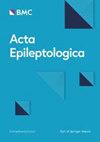Smith-Kingsmore syndrome with nystagmus as the initial symptom
IF 1.2
Q4 CLINICAL NEUROLOGY
引用次数: 0
Abstract
Abstract Background Smith-Kingsmore syndrome (SKS) is a rare autosomal dominant disorder caused by de novo mutations of gene MTOR in most cases and germline mosaicism in a few cases. The first case of SKS was reported in 2013. The incidence of SKS remains unknown. The clinical manifestations of SKS are diverse, and common features are macrocephaly, intellectual disability, and seizures. Some patients with SKS have special facial features. Case presentation The case was a 5-month-old baby girl, who was admitted to the hospital for nystagmus, delayed development for 2 months, and intermittent convulsions for 2 days. The patient had a head circumference of 42 cm (+ 2SD), and showed facial deformity, low limb muscle tension, large areas of pigmentation, as well as mosaic patchy and strip-like pigment loss in her trunk and limbs. Meanwhile, her development was lagging behind peers. Physical examination did not reveal other abnormalities. She was diagnosed with SKS based on whole-exome sequencing combined with clinical symptoms and signs. She successively received treatment with adrenocorticotropic hormone, methylprednisolone sodium succinate, topiramate, levetiracetam, and zonisamide to reduce the number of convulsions in a short time, but drug resistance appeared thereafter. After combined treatment with multiple antiseizure medications, the patient still had seizures, but the amplitude of limb movement during the seizures was reduced compared to that before treatment. Conclusions This case expanded the phenotypic spectrum of SKS for diagnosis. We also review the related literature to promote the awareness, diagnosis, clinical management, and follow-up of SKS patients with MTOR mutations.史密斯-金斯莫尔综合征以眼球震颤为首发症状
背景Smith-Kingsmore综合征(SKS)是一种罕见的常染色体显性遗传病,多数由MTOR基因的新生突变引起,少数由种系嵌合体引起。首例SKS病例于2013年报告。SKS的发病率尚不清楚。SKS的临床表现多种多样,常见的特征是大头畸形、智力障碍和癫痫发作。一些SKS患者有特殊的面部特征。病例为一名5个月大的女婴,因眼球震颤、发育迟缓2个月、间歇性惊厥2天入院。患者头围42 cm (+ 2SD),面部畸形,下肢肌肉紧张,大面积色素沉着,躯干及四肢出现马赛克斑片状、条状色素丢失。与此同时,她的发展落后于同龄人。体格检查未发现其他异常。根据全外显子组测序并结合临床症状和体征,诊断为SKS。先后给予促肾上腺皮质激素、甲泼尼龙琥珀酸钠、托吡酯、左乙拉西坦、唑尼沙胺治疗,短时间内减少惊厥次数,但此后出现耐药。经多种抗癫痫药物联合治疗后,患者仍有癫痫发作,但癫痫发作时肢体运动幅度较治疗前有所降低。结论本病例扩大了SKS的表型谱,为诊断提供了依据。我们也回顾了相关文献,以提高对MTOR突变的SKS患者的认识、诊断、临床管理和随访。
本文章由计算机程序翻译,如有差异,请以英文原文为准。
求助全文
约1分钟内获得全文
求助全文
来源期刊

Acta Epileptologica
Medicine-Neurology (clinical)
CiteScore
2.00
自引率
0.00%
发文量
38
审稿时长
20 weeks
 求助内容:
求助内容: 应助结果提醒方式:
应助结果提醒方式:


